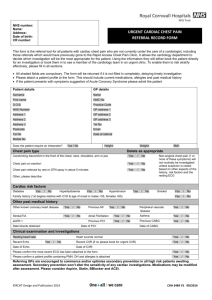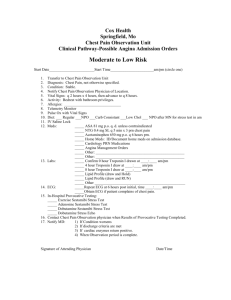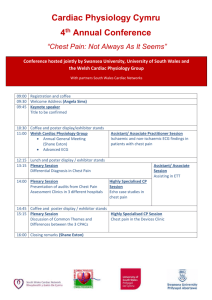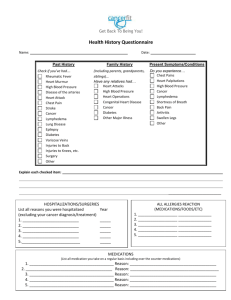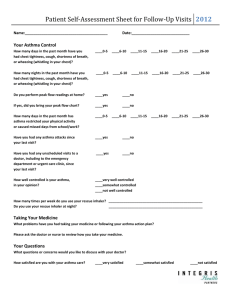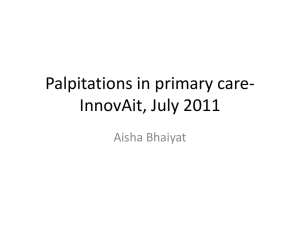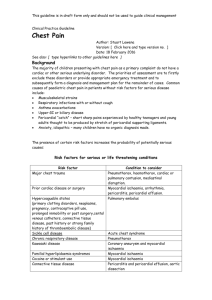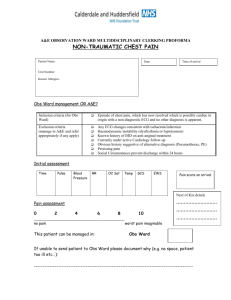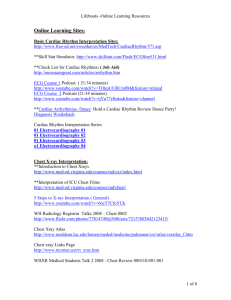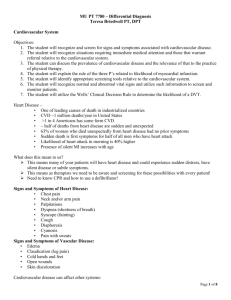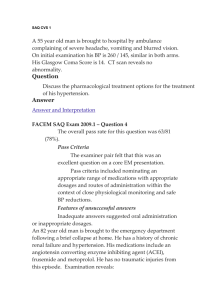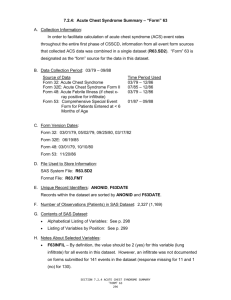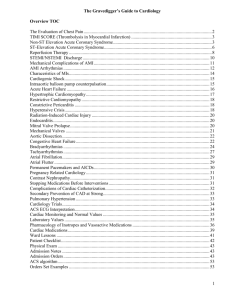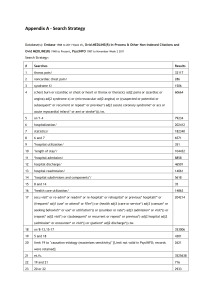Research Projects - Funandeducation.org
advertisement
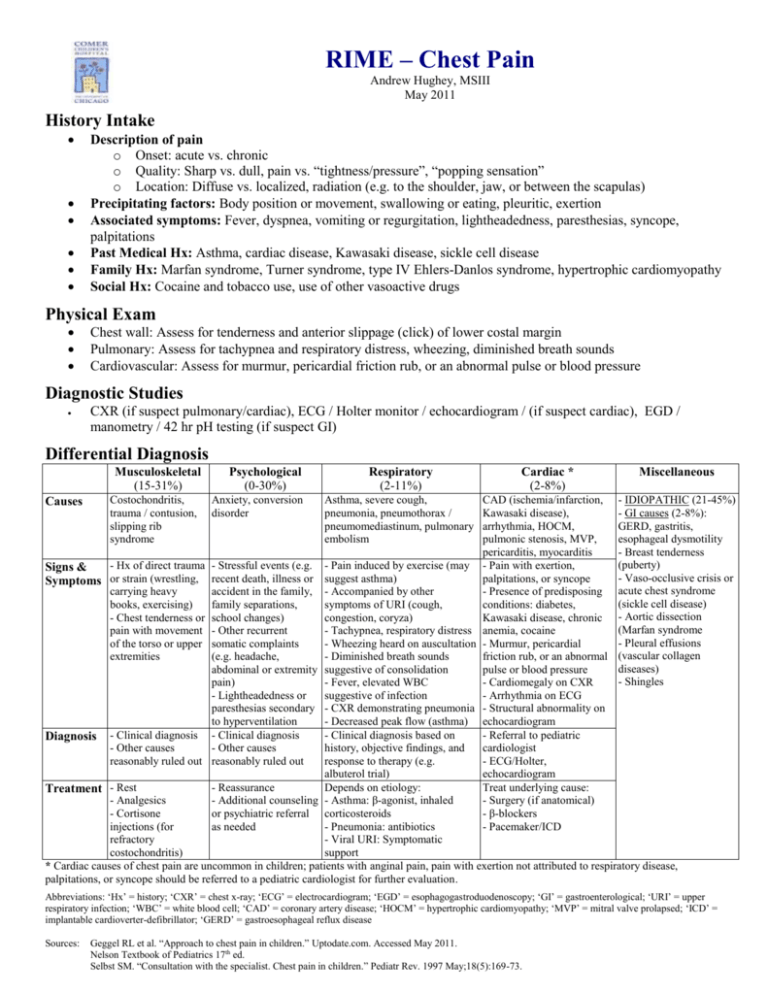
RIME – Chest Pain Andrew Hughey, MSIII May 2011 History Intake Description of pain o Onset: acute vs. chronic o Quality: Sharp vs. dull, pain vs. “tightness/pressure”, “popping sensation” o Location: Diffuse vs. localized, radiation (e.g. to the shoulder, jaw, or between the scapulas) Precipitating factors: Body position or movement, swallowing or eating, pleuritic, exertion Associated symptoms: Fever, dyspnea, vomiting or regurgitation, lightheadedness, paresthesias, syncope, palpitations Past Medical Hx: Asthma, cardiac disease, Kawasaki disease, sickle cell disease Family Hx: Marfan syndrome, Turner syndrome, type IV Ehlers-Danlos syndrome, hypertrophic cardiomyopathy Social Hx: Cocaine and tobacco use, use of other vasoactive drugs Physical Exam Chest wall: Assess for tenderness and anterior slippage (click) of lower costal margin Pulmonary: Assess for tachypnea and respiratory distress, wheezing, diminished breath sounds Cardiovascular: Assess for murmur, pericardial friction rub, or an abnormal pulse or blood pressure Diagnostic Studies CXR (if suspect pulmonary/cardiac), ECG / Holter monitor / echocardiogram / (if suspect cardiac), EGD / manometry / 42 hr pH testing (if suspect GI) Differential Diagnosis Musculoskeletal (15-31%) Anxiety, conversion disorder Respiratory (2-11%) Cardiac * (2-8%) Miscellaneous CAD (ischemia/infarction, - IDIOPATHIC (21-45%) Kawasaki disease), - GI causes (2-8%): arrhythmia, HOCM, GERD, gastritis, pulmonic stenosis, MVP, esophageal dysmotility pericarditis, myocarditis - Breast tenderness (puberty) - Hx of direct trauma - Stressful events (e.g. - Pain induced by exercise (may - Pain with exertion, Signs & - Vaso-occlusive crisis or palpitations, or syncope Symptoms or strain (wrestling, recent death, illness or suggest asthma) carrying heavy accident in the family, - Accompanied by other - Presence of predisposing acute chest syndrome (sickle cell disease) books, exercising) family separations, symptoms of URI (cough, conditions: diabetes, - Chest tenderness or school changes) congestion, coryza) Kawasaki disease, chronic - Aortic dissection (Marfan syndrome pain with movement - Other recurrent - Tachypnea, respiratory distress anemia, cocaine - Pleural effusions of the torso or upper somatic complaints - Wheezing heard on auscultation - Murmur, pericardial extremities (e.g. headache, - Diminished breath sounds friction rub, or an abnormal (vascular collagen diseases) abdominal or extremity suggestive of consolidation pulse or blood pressure - Shingles pain) - Fever, elevated WBC - Cardiomegaly on CXR - Lightheadedness or suggestive of infection - Arrhythmia on ECG paresthesias secondary - CXR demonstrating pneumonia - Structural abnormality on to hyperventilation - Decreased peak flow (asthma) echocardiogram - Clinical diagnosis based on - Referral to pediatric Diagnosis - Clinical diagnosis - Clinical diagnosis - Other causes - Other causes history, objective findings, and cardiologist reasonably ruled out reasonably ruled out response to therapy (e.g. - ECG/Holter, albuterol trial) echocardiogram - Reassurance Depends on etiology: Treat underlying cause: Treatment - Rest - Analgesics - Additional counseling - Asthma: β-agonist, inhaled - Surgery (if anatomical) - Cortisone or psychiatric referral corticosteroids - β-blockers injections (for as needed - Pneumonia: antibiotics - Pacemaker/ICD refractory - Viral URI: Symptomatic costochondritis) support * Cardiac causes of chest pain are uncommon in children; patients with anginal pain, pain with exertion not attributed to respiratory disease, palpitations, or syncope should be referred to a pediatric cardiologist for further evaluation. Causes Costochondritis, trauma / contusion, slipping rib syndrome Psychological (0-30%) Asthma, severe cough, pneumonia, pneumothorax / pneumomediastinum, pulmonary embolism Abbreviations: ‘Hx’ = history; ‘CXR’ = chest x-ray; ‘ECG’ = electrocardiogram; ‘EGD’ = esophagogastroduodenoscopy; ‘GI’ = gastroenterological; ‘URI’ = upper respiratory infection; ‘WBC’ = white blood cell; ‘CAD’ = coronary artery disease; ‘HOCM’ = hypertrophic cardiomyopathy; ‘MVP’ = mitral valve prolapsed; ‘ICD’ = implantable cardioverter-defibrillator; ‘GERD’ = gastroesophageal reflux disease Sources: Geggel RL et al. “Approach to chest pain in children.” Uptodate.com. Accessed May 2011. Nelson Textbook of Pediatrics 17th ed. Selbst SM. “Consultation with the specialist. Chest pain in children.” Pediatr Rev. 1997 May;18(5):169-73.
